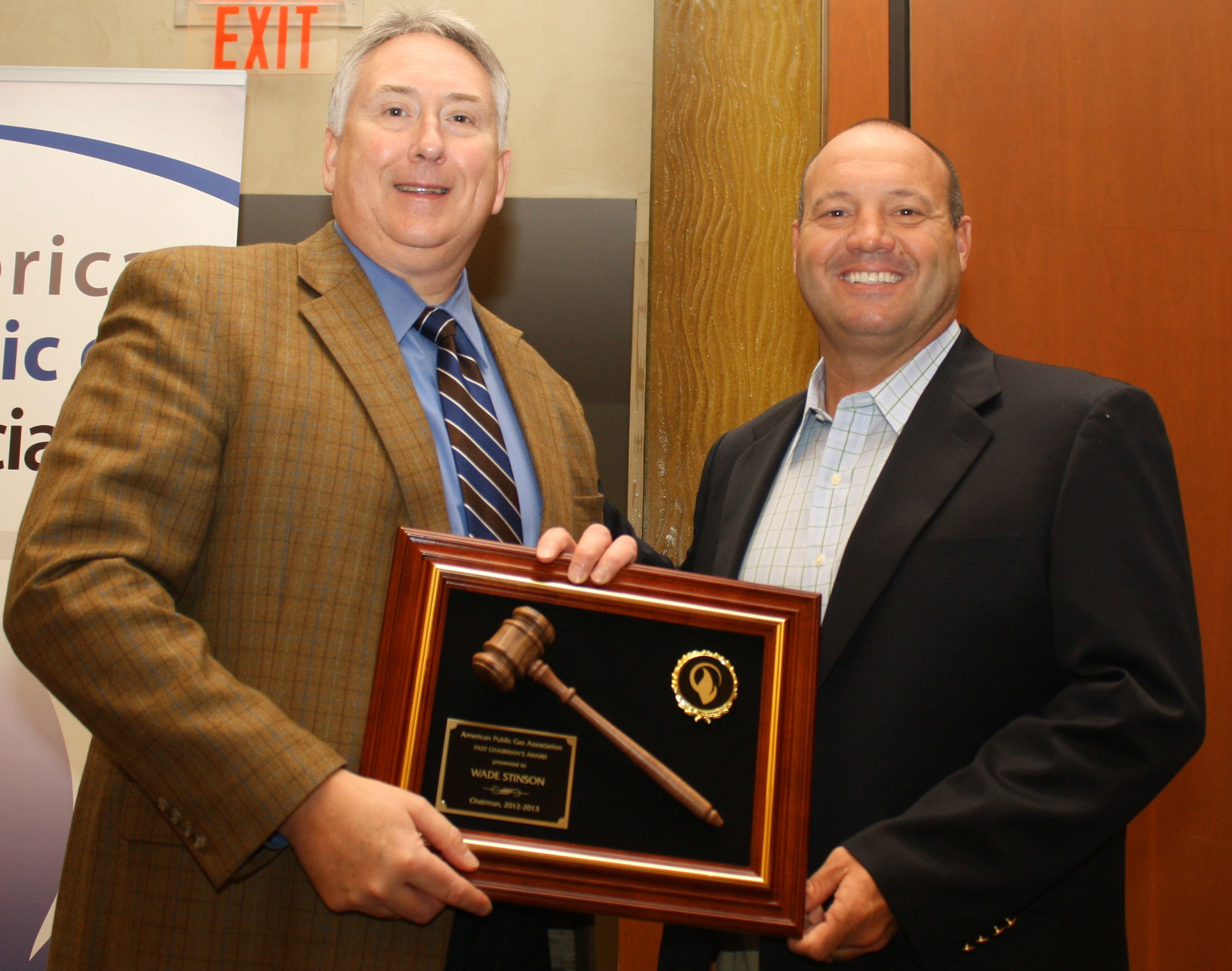October 2013, Vol. 240 No. 10
Features
New APGA Chairman Ballard Knows Full Plate Awaits Him

Matt Ballard, president of Sevier County Utility District in Tennessee, became chairman of the American Public Gas Association (APGA) at its annual meeting in July. He serves on the board of the Tennessee Gas Association (TGA), the TGA education/Steering Committee Board of Directors and is a past member of its Board of Directors. Ballard is also a member of the APGA Operations and Safety Committee.
I’m honored to serve as chairman of the APGA for the coming year, and I believe natural gas is the fuel of choice for the 21st century. APGA has worked hard to ensure the direct use of natural gas continues to play an important role in our nation’s energy policy and that natural gas prices remain at a long-term affordable rate.
The direct use of natural gas can play a critical role in reducing greenhouse gas emissions, increasing overall energy efficiency and reducing our energy dependence. As a result, direct use is one area where I will focus my attention during my tenure as chairman of APGA.
In our natural gas industry, two of the three end-use sectors are seeing significant growth. The demand from the electric generation sector continues as the list of coal plants retirements sees additions almost daily. There is greater demand for natural gas in the industrial sector, too, as we are in the midst of a manufacturing renaissance with companies, which previously moved plants overseas, returning to the U.S. as a result of affordable natural gas prices. In fact, the industrial sector has announced more than 100 capital investments, representing more than $90 billion in spending and millions of new jobs predicated on abundant and affordable natural gas.
In the residential and commercial sector, however, it appears we may be facing an uphill battle in simply preserving the direct use of natural gas. A recent example is our opposition to the Department of Energy’s (DOE) direct final rule that increased the federal minimum efficiency for natural gas furnaces from 78% nationwide to 80% in southern states and 90% in 30 northern states.
While APGA and its members strongly support energy efficiency, we are concerned this rule will ultimately undermine efficiency goals while significantly increasing consumer costs. Only condensing furnaces meet these new efficiency standards in the northern states, and these generally cannot be exhausted through the existing chimney.

The additional venting requirements necessary to accommodate a condensing furnace impose additional costs that may drive consumers to purchase other alternatives to avoid the additional cost of venting. These alternatives could result in higher operating costs and higher energy consumption than an 80% gas furnace when electric generation and transmission losses are counted.
APGA also objects to this misuse of the direct final rule process, intended for quick implementation of emergency or non-controversial rules. The efficiency standard is neither. Despite substantive comments challenging the bases for the rule submitted by APGA and others, DOE ruled that it did not receive adverse comments warranting withdrawal of the direct final rule. In December 2011, APGA filed a petition for review of this rule in the U.S. Court of Appeals for the D.C. Circuit.
APGA argued that DOE violated the Energy Policy and Conservation Act requirements by, among other things, failing to economically justify the new 90% standard, banning a product class, failing to withdraw the direct final rule despite substantive opposition by relevant parties, ignoring fuel switching and relying on non-transparent documents to support its economic justification. APGA asked the court to vacate the direct final rule and remand the matter to DOE for a notice-and-comment rulemaking.
To avoid going to court, APGA entered into mediation with DOE and the Department of Justice (DOJ), which is representing DOE. From APGA’s perspective, the mediation was very productive as it resulted in a settlement motion that vacated the direct final rule. The motion has yet to be approved by the court, but we hope it will be approved shortly.
APGA has also pushed for an expansion of the direct use of natural gas in natural gas vehicles (NGVs). APGA believes strongly that clean, affordable and secure natural gas has a critical role to play in U.S. transportation policy. The deployment NGVs can enhance our national security by reducing imported oil from hostile or unstable regimes. Reducing imported oil can also improve our balance of trade and in so doing, help to protect the value of the dollar.
In addition, using NGVs can contribute to national goals to reduce greenhouse gas emissions. For example, the replacement of an older gasoline-powered vehicle with a new NGV reduces emissions of carbon monoxide by 70-90% and nitrogen oxides by 75-95%. In sum, the use of NGVs can aid in the critical national goals of reducing our energy dependence, improving our balance of trade and reducing harmful greenhouse gas emissions. Given these benefits, NGVs make all the sense in the world, and that is why many public gas systems, including mine – the Sevier County Utility District, are moving toward using NGV fleet vehicles and installing NGV fueling stations.
On another issue, reforming Section 5 of the Natural Gas Act (NGA) remains a top priority for APGA. The NGA regulates the relationship between interstate transmission pipelines and LDCs. It mandates that the rates charged to customers of interstate pipelines must be “just and reasonable.” APGA believes that customers are being significantly overcharged by interstate pipelines.
The Natural Gas Supply Association (NGSA), which represents natural gas producers, publishes a study showing that interstate pipelines are charging an additional $680 million every year beyond a just and reasonable rate. These are dollars that are being taken out of homeowners’ and business’ pockets and are flowing upstream to pipelines.
APGA wants the Federal Energy Regulatory Commission (FERC) to have authority to provide refunds to customers that have been overcharged.
FERC already has such refund authority on the electric side under the Federal Power Act Section 206. In short, this is a common-sense remedy to a very real consumer fairness and business competitiveness issue. APGA continues to work with relevant committees to include this important reform in any upcoming energy legislation.
Another critical issue for APGA is the export of domestically produced natural gas in the form of liquefied natural gas (LNG). There are about 20 applications to export LNG that have been filed at the DOE. If all of these facilities are built, about 28.54 Bcf/d – or 41% of daily U.S. natural gas production – would be exported (U.S. daily production is about 69 Bcf/d).
The real point at issue is exports of LNG to countries with which the United States does not have a Free Trade Agreement (FTA), as exports to FTA countries are automatic under the NGA. Exports of LNG to non-FTA countries (those which do not allow the U.S. broad access to their markets) are assumed to be in the public interest unless opponents prove otherwise.
To date, three applications for export to non-FTA countries have been approved totaling 5.6 Bcf/d, and APGA expects the DOE will continue to approve additional applications for export on its established 60-day cycle.
(Editor’s note: On Sept. 11, after Mr. Ballard’s article was written, DOE announced it had approved Dominion’s Maryland Cove Point LNG facility for natural gas exports to non-FTA countries. It was the fourth such approval.)
APGA opposes the export of domestically produced LNG for four primary reasons:
1. Price impacts: Every study done by government or non-government entities shows that the domestic price of natural gas increases with LNG exports. These increases range from 3-9%, according to a DOE study, and up to 40%, according to a peer-reviewed Purdue University study. In short, domestic homeowners and businesses that use natural gas will see their prices increase.
2. Domestic demand: The domestic demand for natural gas is expected to increase significantly over the next three decades. Somewhere between 50-70 gigawatts of coal-fired electric generation is expected to be retired, and the lion’s share of that will be replaced with natural gas. That could mean an additional 10-11 Bcf/d worth of demand from electric generation alone.
3. NGVs: The vehicles are price-competitive with their gasoline counterparts due to significantly lower fuel costs, which provide economically viable payback periods. NGVs reduce our dependence on foreign oil, produce fewer harmful emissions and enhance our national security. Put simply, exports of LNG make NGVs less economical by increasing the fuel price, thereby risking significant energy and national security goals.
4. Manufacturing: The low and stable domestic price of natural gas has created a manufacturing renaissance for U.S. major chemical and steel manufacturers, such as Dow Chemical, Nucor Steel, Eastman and Celanese, which have more than $100 billion of private capital ready to be invested in new U.S. manufacturing in the coming years. Exports of LNG, which increase the domestic price of gas directly, threaten those investments and the jobs they create, as manufacturers are highly price-sensitive with respect to natural gas.
APGA believes the consequences of unfettered exports of LNG are clear: energy price increases, a lost opportunity to reduce our dependence on foreign oil and a squandered manufacturing renaissance. Given these costs, APGA believes the wise policy choice at this time is to prohibit the export of domestically produced LNG.
APGA will continue to monitor pipeline safety regulations coming out of the Pipeline and Hazardous Materials Safety Administration (PHMSA). PHMSA has its plate full with a host of regulations required by the Pipeline Safety, Regulatory Certainty and Job Creation Act of 2011, and National Transportation Safety Board (NTSB) safety recommendations following the San Bruno, CA accident, mostly concerned with transmission pipe.
Only about 5% of APGA members own pipe classified as transmission, however, virtually all APGA members buy gas that is transported through transmission pipes, so presumably the pipelines will want to pass on any increased testing and inspection costs to their LDC customers. We will be closely monitoring these rules to ensure any costs are justified by projected safety benefits.
Through our participation on the APGA Security and Integrity Foundation (SIF), we continue to provide products and services to help smaller LDCs operate safely in full compliance with federal and state pipeline safety rules. More than 1,600 systems have used the SHRIMP tool to create their Distribution Integrity Management Programs (DIMP) plans.
Though less well-known, the SIF also has a drug and alcohol compliance plan creation tool and is working on a tool to write operations and maintenance manuals for small systems. Most APGA members don’t have in-house engineering or other staff support and often feel overwhelmed by the seemingly endless stream of rules coming out of Washington, DC. APGA will continue to provide model plans and other guidance to assist members to keep up with regulatory requirements.
At an August PHMSA public meeting, the American Petroleum Institute (API) reported on the development of a Recommended Practice for Pipeline Safety Management Systems. This standard would tie together all of an operator’s safety programs and ensure that a “safety culture” exists from the field to top management in pipeline operations.
The challenge for the committee is to craft a document that is flexible enough that it makes sense for the very largest interstate pipelines as well as the smallest municipal gas utilities. APGA is participating on the drafting committee on behalf of the approximately 1,000 public gas systems that could be affected by the recommended practice.
That is a very full plate for a relatively small association like APGA. We rely on many volunteers who serve on our committees and subcommittees to support the 10 full-time APGA staff. We also are supported by many elected and appointed officials who not only encourage their utility personnel to participate on APGA committees, but also make personal contact with senators and representatives in support of APGA’s positions.





Comments